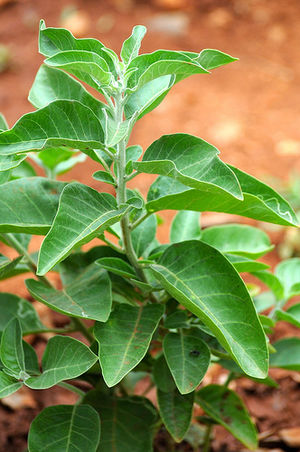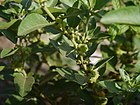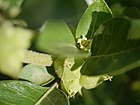Note: This is a project under development. The articles on this wiki are just being initiated and broadly incomplete. You can Help creating new pages.
Difference between revisions of "Withania somnifera - Ashwagandha"
(→Common names) |
|||
| Line 13: | Line 13: | ||
==Common names== | ==Common names== | ||
| − | {{Common names|kn=|ml=|sa=|ta=|te=|hi=|en= | + | {{Common names|kn=Kanchuki|ml=Amukkuram|sa=|ta=Amukkuram|te=Vajigandha|hi=Ashwagandha|en=Ashwagandha, Indian ginseng}} |
==Properties== | ==Properties== | ||
Revision as of 13:56, 16 June 2018
Withania somnifera is a herb which is being used in ayurvedic medicines since our ancient times. it plays a major role in the regulation of vata dosha which is one of the fundamental bioelement.
Contents
- 1 Uses
- 2 Parts Used
- 3 Chemical Composition
- 4 Common names
- 5 Properties
- 6 Habit
- 7 Identification
- 8 List of Ayurvedic medicine in which the herb is used
- 9 Where to get the saplings
- 10 Mode of Propagation
- 11 How to plant/cultivate
- 12 Commonly seen growing in areas
- 13 Photo Gallery
- 14 References
- 15 External Links
Uses
Wounds, Cuts, Snakebites, Curing liver disorders, Skin eruptions, Blotches, Pimples, Diarrhea, Sore throats
Parts Used
Chemical Composition
The ashwagandha consists of alkaloids and steroidal lactones. Withanine is the main alkaloid, where as somniferine, somnine, somniferinine, withananine, pseudo-withanine, tropine, pseudo tropine, choline, cuscohygrine, isopelletierine, anaferine, anahydrine[1]
Common names
| Language | Common name |
|---|---|
| Kannada | Kanchuki |
| Hindi | Ashwagandha |
| Malayalam | Amukkuram |
| Tamil | Amukkuram |
| Telugu | Vajigandha |
| Marathi | NA |
| Gujarathi | NA |
| Punjabi | NA |
| Kashmiri | NA |
| Sanskrit | |
| English | Ashwagandha, Indian ginseng |
Properties
Reference: Dravya - Substance, Rasa - Taste, Guna - Qualities, Veerya - Potency, Vipaka - Post-digesion effect, Karma - Pharmacological activity, Prabhava - Therepeutics.
Dravya
Rasa
Tikta (Bitter), Kashaya (Astringent)
Guna
Laghu (Light), Ruksha (Dry), Tikshna (Sharp)
Veerya
Ushna (Hot)
Vipaka
Katu (Pungent)
Karma
Kapha, Vata
Prabhava
Habit
Identification
Leaf
| Kind | Shape | Feature |
|---|---|---|
| Simple | The leaves are alternate, simple, margins entire to slightly wavy, broadly ovate, obovate or oblong, 30-80 mm long and 20-50 mm broad |
Flower
| Type | Size | Color and composition | Stamen | More information |
|---|---|---|---|---|
| Bisexual | 2-5 mm long | Yellow | 5 | The 1-7 inconspicuous bisexual flowers appear at the leaf nodes on 2-5 mm long stalks |
Fruit
| Type | Size | Mass | Appearance | Seeds | More information |
|---|---|---|---|---|---|
| 5-8 mm | The fruit is a hairless spherical berry | orange-red to red when ripe and enclosed by the enlarged calyx | - | {{{6}}} |
Other features
List of Ayurvedic medicine in which the herb is used
- Vishatinduka Taila as root juice extract
Where to get the saplings
Mode of Propagation
How to plant/cultivate
A fairly easily grown plant, it requires a warm sheltered position in full sun and a well-drained moderately fertile soil[3]
Commonly seen growing in areas
Photo Gallery
References
External Links
- Ayurvedic Herbs known to be helpful to treat Wounds
- Ayurvedic Herbs known to be helpful to treat Cuts
- Ayurvedic Herbs known to be helpful to treat Snakebites
- Ayurvedic Herbs known to be helpful to treat Curing liver disorders
- Ayurvedic Herbs known to be helpful to treat Skin eruptions
- Ayurvedic Herbs known to be helpful to treat Blotches
- Ayurvedic Herbs known to be helpful to treat Pimples
- Ayurvedic Herbs known to be helpful to treat Diarrhea
- Ayurvedic Herbs known to be helpful to treat Sore throats
- Herbs with Dried Folaige used in medicine
- Herbs with Whole herb used in medicine
- Herbs with common name in Kannada
- Herbs with common name in Hindi
- Herbs with common name in Malayalam
- Herbs with common name in Tamil
- Herbs with common name in Telugu
- Herbs with common name in English
- Habit - Herb
- Index of Plants which can be propagated by Seeds
- Index of Plants which can be propagated by Cuttings
- Herbs that are commonly seen in the region of Open places
- Herbs that are commonly seen in the region of disturbed areas
- Herbs






